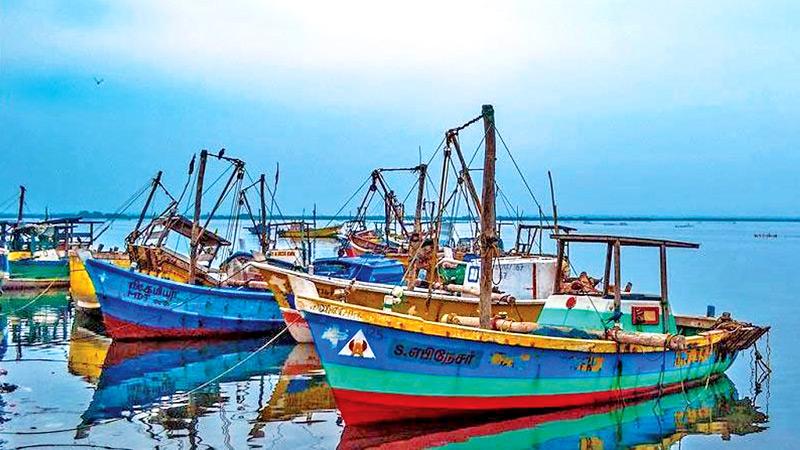
Being an island nation Sri Lanka has many beach destinations. Every beach town has its dazzling identity. There is an island in the Northern Province, about 17 km from Jaffna, a serene paradise. Karainagar is a quiet town located on the island of Karaithivu (island of karai trees). This is a destination that truly manifests the majesty of the ocean. It is one of the last Northern towns that has not been commercially intruded and retains its ancient charms. It can be reached from Jaffna town. On this visit I opted to take the bus bearing number 782 from the Jaffna town. Locals have an awkward way of branding buses, hence 782 is known as a ‘depot bus’, because it terminates at the Valanthalai CTB bus depot.
Crossing the causeway
 The island is connected to the mainland by a lengthy causeway. There isn’t much traffic which allows the traveller to absorb the stunning views on both sides. I saw green nets on either side, where men stood waist deep in the emerald green water, checking their prawn nets. As we neared the end of the causeway a massive arch was visible, with the name of the town. Above the arch was a stone carving of Nandi (the cow venerated by Hindus). One of the first signs of activity was a small fish market, with bicycles stacked neatly on one side.
The island is connected to the mainland by a lengthy causeway. There isn’t much traffic which allows the traveller to absorb the stunning views on both sides. I saw green nets on either side, where men stood waist deep in the emerald green water, checking their prawn nets. As we neared the end of the causeway a massive arch was visible, with the name of the town. Above the arch was a stone carving of Nandi (the cow venerated by Hindus). One of the first signs of activity was a small fish market, with bicycles stacked neatly on one side.
Valanthalai is a quiet town laced with coconut and palmyrah trees. The silence was welcoming when compared to the traffic of Colombo. The northern sun was gracefully receding. The bicycle is the trusted source of transport on this island. Every house had at least two cycles. Khomba, tamarind and jak trees dominated some gardens offering shade.
The lifestyle of the people here coexists alongside nature. The residence of my friend was a house depicting colonial design with an extended verandah. A refreshing well bath followed by a glass of nelli crush, set the tone for this island adventure. Fresh water wells are a prized possession in Karainagar. The wells are pretty deep. The fresh water retains a mild flavour of lime from the limestone sediment.
I woke up the next morning to the crowing of a pompous rooster. As the sunlight began to adorn the morning sky, my friend Vincent invited me to visit a nearby shop. The road now showed an increase in bicycles as people were engaged in their morning tasks. Those who reared cows and goats were busy taking freshly cut branches. Another robust man was transporting fresh milk in two large silver buckets on a motorcycle. A small tractor passed by loaded with king coconuts.
Captivating kovils
We reached a small shop with no name board. A man seated behind the solitary desk grinned, his teeth stained with betel chewing. He greeted us saying vanakkam and pointed towards the right, where a pretty woman was making paal appam (hoppers infused with sweetened coconut milk).

Having purchased a dozen hoppers we walked back home. By now students and teachers were cycling to school, engaged in carefree conversation. By 8.30 am I hired a three wheeler and we began to drive around. I was told that Karainagar had a faithful Hindu population, which gave rise to 36 kovils of various size, based on significance.
There are eight kovils dedicated to Vinayagar, 13 to the deity Amman, nine kovils venerate Murugan and six kovils are home to Vairavar. Of course you can’t visit all of them in a day so we visited two of the main kovils. The main Sivan kovil is one of the oldest.
Its tower rises into the sky, with a belfry on the right. The Valanthalai Amman kovil is another beautiful venue displaying an explosion of colour. The gopuram (tower) is adorned with many statues. The arched roof leading to the inner sanctum manifests with intricate paintings on a bright blue background.
The annual vel (chariot) festival of this kovil is said to be a vibrant affair with grand celebrations. As we journeyed back we could see a few smaller kovils bordering cultivated fields, away from the main road.
There is a ferry service in this area that takes you to Kayts, another prominent island. Karainagar is home to a unique Dutch period fort named Hammenhiel, which stands majestically in the sea. Access to the fort is with the permission of the Navy. In the evening we visited the fish market.
The bargaining was quite friendly which resulted in a succulent prawn curry for dinner. The next morning I visited Casurina beach. The undisturbed beach areas deserve a systematic development upgrade.
Local women engage in making lime pickle and dried chili soaked in curd. By evening the town becomes quiet as people prefer to remain at home with their family. Karainagar is the ideal Northern getaway that produces lasting travel memories.
